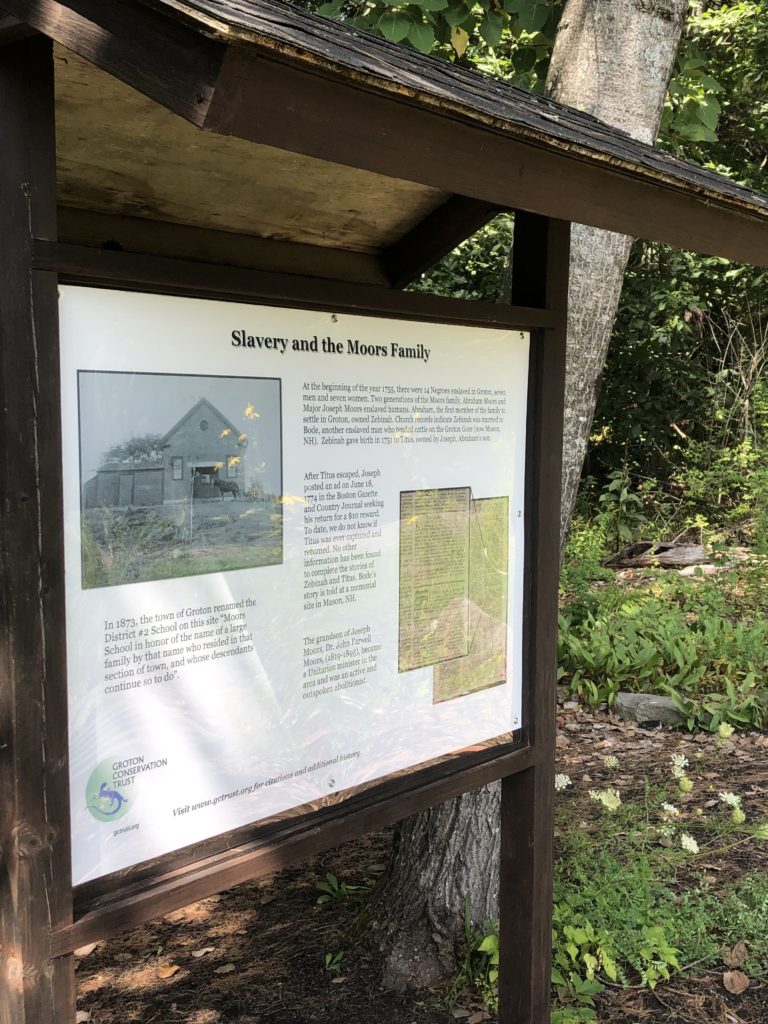By Alice Cary
For thirty years, longtime Groton Conservation Trust (GCT) member Rick Muehlke has occasionally stared at a marble plaque dedicated to Major Joseph Moors and his son, Benjamin, in the sanctuary of Groton’s Unitarian church. Joseph was a soldier at the Siege of Louisburg in 1758 in what is now Canada and later a captain in Colonel Prescott’s regiment at the Battle of Bunker Hill. Muehlke knew that the name was related to a GCT parcel known as The Moors Schoolhouse Site, a small triangular area bordered by Farmers Row, Moors Road, and Culver Street.
So it came as quite a shock when Muehlke and other members of the GCT learned a disturbing fact about Joseph Moors during a presentation by local historian Joshua Vollmar—Moors and his father both owned people. Abraham Moors, the first in the family to settle in Groton, owned Zebinah, and son Joseph owned Titus, Zebinah’s son.
“My initial reaction was surprise and disappointment,” Muehlke says.
“I was immediately alarmed and appalled,” adds GCT Vice-President Susan Hughes. “I knew this revelation presented a challenge for the GCT and that we needed to address our relationship to this painful history.” Hughes even believed the GCT should change the name.
But before taking a vote on the name change, all trustees agreed to investigate further and to tell the complete story once it was learned, regardless of whether the name changed. Months of careful consideration and additional research by Hughes, Muehlke, and Ed McNierney ensued. They learned the site was the home of one of Groton’s one-room schoolhouses, originally called “District #2 School.” In 1873, by a town meeting vote, the property was renamed in honor of the generations of Moors who had lived in the area, not specifically for Major Moors or his father. Interestingly, one of Joseph Moors’ grandsons, Dr. John Farwell Moors (1819-1895), became a Unitarian minister and was an active, outspoken abolitionist.
Few details could be found about the enslaved people. Zebinah married Bode, whose story has been memorialized in a statue in Mason, New Hampshire. Their son, Titus, was born in 1751 and later escaped. On June 18, 1774, Joseph Moors placed an ad in the Boston Gazette and Country Journal asking for his return for a ten-dollar reward.
Ultimately, in June, after lengthy discussions and solicitation of opinions from the GCT’s Advisory Council, the GCT voted 8-6-1 to keep the Moors name. Over the summer, the GCT updated the Moors property kiosk with signage that tells a more complete story of the Moors family, and they have plans to partner with other local groups to continue to share the story of enslavement in Groton.

“I am disappointed in the vote—I can’t lie,” Hughes admits. “I felt this was an opportunity to address systemic racism, even in a small way, by removing the name of enslavers from the property.”
“Our vote to retain the name was as close as any I can recall and all the reasons for and against were thoughtful and varied,” notes GCT President Mark Gerath. “When I thought that the school was named for Joseph Moors, I was in favor of a name change. My opinion changed when I understood that the naming was for the larger family, including a noted abolitionist.” Trust members praised the group’s decision-making process. “We did not rush to make decisions, and we encouraged long and heartfelt discussions,” Muehlke says.
The GCT also hopes that by telling the story of the Moors family, more information will come out. “I hope the public would help us all learn more about Zebinah and Titus,” Muehlke notes. “I’m looking forward to more research and information from the public on all other individuals enslaved in Groton and nearby towns. I’m also very curious about Abraham, Joseph, and other members of the Moors family.”
The GCT is just one of a wide variety of groups across the nation that are grappling with such issues of historical reckoning. The Sierra Club, for instance, has denounced John Muir’s racist statements and pledged to diversify its leadership.
“There were many heartfelt opinions expressed,” explains Ted Lapres, a Trustee who was GCT president until May. “While we had differing opinions on the issue of the name, we unanimously agreed that we needed to both educate the broader town on the issue and use the kiosk space at the Moors Schoolhouse site to more fully address the history of the Moors family and the slave ownership of two generations of Moors. Throughout the whole process, I felt our Trustees were thoughtful, inquisitive, and deeply respectful of others’ opinions even when their own differed. While it represented an emotional issue, the manner in which we approached it, in my opinion, strengthened the bond and respect our Trustees had for each other. And I believe, leaves us better positioned as a team to work together on future matters of the Trust.”
Gerath adds: “I think that understanding that slavery existed in Groton is very important. The history is more complicated than the common perception that the town, and New England, were squarely on the side of abolition.”
In addition to the update to The Moors Schoolhouse Site, the GCT is sponsoring a walk that addresses the Moors Schoolhouse legacy on Sunday, September 19, at 2:00 PM, led by Joshua Vollmar and leaving from The General Field.
The complete story and all the research can be found on the GCT website.

